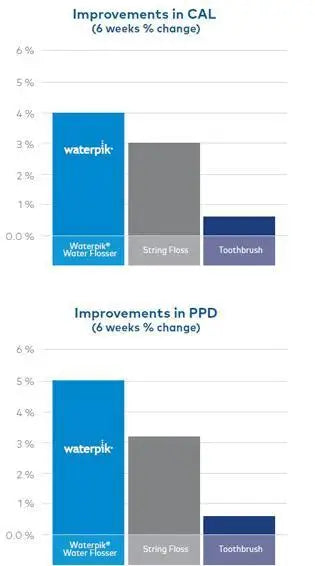Evaluation of Water Flosser Safety at High Pressure Settings
Goyal CR, Lyle DM, Qaqish JG, Schuller R. Evaluation of the safety of a water flosser on gingival and epithelial tissue at different pressure settings. Compend Contin Educ Dent 2018; 39(Suppl. 2):8–13.
Objective
To evaluate the safety of the Waterpik™ Water Flosser on gingival and epithelial tissue at high pressure settings.
Methodology
One hundred and five subjects were randomly assigned to one of three treatment groups in this six-week, parallel clinical trial:
-
Waterpik Water Flosser plus manual toothbrush (WF)
-
String floss plus manual toothbrush (SF)
-
Manual toothbrush only (MT)
Data were collected on six designated teeth at baseline, two weeks, four weeks, and six weeks for clinical attachment level (CAL), probing pocket depth (PPD), and oral soft tissue (OST).
For CAL and PPD, data were recorded at six sites per tooth.
Subjects brushed twice daily using the supplied toothbrush and toothpaste. Written and verbal instructions were provided for the WF and SF groups. The WF group adjusted pressure settings as instructed: levels 4–8 for two weeks, 9 for two weeks, and 10 for two weeks.
Results
No adverse effects were reported. The Waterpik Water Flosser demonstrated stability in clinical attachment level and probing pocket depth, with results comparable to or better than string floss and manual brushing alone.
No negative impact on oral soft tissue was observed.
Conclusion
This study confirms that the Waterpik Water Flosser, even at high pressure settings, is safe and does not negatively affect gingival tissue or epithelial attachment. In fact, improvements in CAL and PPD were observed in the Water Flosser group.
